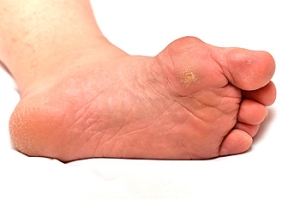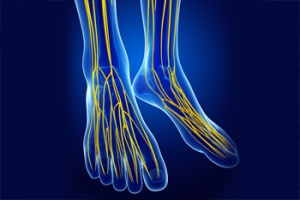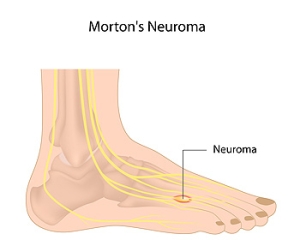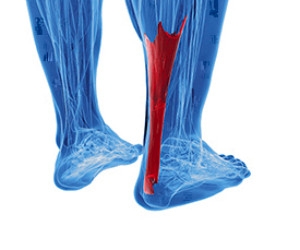Connect With Us
Featured Articles

What’s the Difference Between Corns and Calluses?
 Corns and calluses are both hardened layers of dead skin that can develop on the feet to protect them from stress, irritation and rubbing that has occurred over a period of time—usually as a result of wearing ill-fitting shoes or friction between the toes. The difference between corns and calluses is where they are located: calluses are on the bottom of the toes, and corns are on a bony area on the top of the foot. Corns also have a thick “core” of skin at their base and are either hard (on the top of the toes), or soft (between the toes). Corns, like calluses, can be painful and cause difficulty walking. Occasionally, a little blood may collect where the skin of the foot and the corn meet and cause discoloration or even split the skin and allow an infection to possibly occur. You can help avoid getting a corn by wearing properly sized shoes with plenty of room for the toes to move. If the corn does not go away on its own over several months, or is causing pain or difficulty walking, a podiatrist may relieve discomfort or even remove pressure and pain from the area by safely shaving away some of the dead skin. They may also be able to correct any structural issue you might have using orthotics to distribute weight more evenly.
Corns and calluses are both hardened layers of dead skin that can develop on the feet to protect them from stress, irritation and rubbing that has occurred over a period of time—usually as a result of wearing ill-fitting shoes or friction between the toes. The difference between corns and calluses is where they are located: calluses are on the bottom of the toes, and corns are on a bony area on the top of the foot. Corns also have a thick “core” of skin at their base and are either hard (on the top of the toes), or soft (between the toes). Corns, like calluses, can be painful and cause difficulty walking. Occasionally, a little blood may collect where the skin of the foot and the corn meet and cause discoloration or even split the skin and allow an infection to possibly occur. You can help avoid getting a corn by wearing properly sized shoes with plenty of room for the toes to move. If the corn does not go away on its own over several months, or is causing pain or difficulty walking, a podiatrist may relieve discomfort or even remove pressure and pain from the area by safely shaving away some of the dead skin. They may also be able to correct any structural issue you might have using orthotics to distribute weight more evenly.
Corns can make walking very painful and should be treated immediately. If you have questions regarding your feet and ankles, contact Dr. Howard Horowitz of Bowie Foot & Ankle . Our doctor will treat your foot and ankle needs.
Corns: What Are They? And How Do You Get Rid of Them?
Corns are thickened areas on the skin that can become painful. They are caused by excessive pressure and friction on the skin. Corns press into the deeper layers of the skin and are usually round in shape.
Ways to Prevent Corns
There are many ways to get rid of painful corns such as:
- Wearing properly fitting shoes that have been measured by a professional
- Wearing shoes that are not sharply pointed or have high heels
- Wearing only shoes that offer support
Treating Corns
Although most corns slowly disappear when the friction or pressure stops, this isn’t always the case. Consult with your podiatrist to determine the best treatment option for your case of corns.
If you have any questions please feel free to contact our office located in Bowie, MD . We offer the newest diagnostic and treatment technologies for all your foot and ankle needs.
Everything You Need to Know About Corns
Corns are hard and thick areas of skin that form as a result of constant rubbing, friction, or pressure on the skin. They are patches of dead skin with a small plug toward the center. They may appear on the tops and sides of toes and can make walking painful.
Soft corns are typically thinner with a white color and rubbery texture. Soft corns tend to appear between the toes. Seed corns are another type of corn that appear in clusters and can be tender if they are on a weight-bearing part of the foot. Seed corns usually appear on the bottom of the foot and are likely caused by a blockage in sweat ducts.
While corns and calluses are somewhat similar, calluses are a bit different. Calluses are a patch of dead skin that can occur anywhere on the body. In comparison to corns, calluses are usually a bit larger in size. However, both corns and calluses are caused by increased friction on the skin.
There are some risk factors that may increase your chances of developing corns and calluses. If you have bunions, hammertoe, or a bone spur, you are more likely to develop a corn or callus on your foot.
While Corns and Calluses tend to disappear when the friction to the affected area ceases, the help of a podiatrist may be useful in the removal process. It is important to remove the dead skin around the area and this may be done in a few different ways. Moisturizing creams may be helpful in softening and removing the dead skin around the callus. You should never use razors or other pedicure equipment to remove your corns. Doing this may worsen your corn or callus and cause infection.
In some cases, corns and calluses may be caused by abnormal foot structure or walking motion. In such a case, you should seek a podiatrist’s assistance in order to correct the issue.
How to Reduce Ankle Swelling During Pregnancy
 Swelling in the feet and ankles is common during pregnancy, when your body naturally retains more fluids and exerts extra pressure on your lower limbs. However, swollen ankles can be uncomfortable and unpleasant. You may be able to reduce ankle swelling by avoiding standing for prolonged periods of time and by frequently resting and elevating your feet. While sitting, gently rotate and flex your feet at the ankles to stretch and strengthen the calf muscles. Participating in regular, low impact physical activities, like walking, riding a stationary bike, or swimming may also help reduce ankle swelling. For more information about pregnancy and foot health, please consult with a podiatrist.
Swelling in the feet and ankles is common during pregnancy, when your body naturally retains more fluids and exerts extra pressure on your lower limbs. However, swollen ankles can be uncomfortable and unpleasant. You may be able to reduce ankle swelling by avoiding standing for prolonged periods of time and by frequently resting and elevating your feet. While sitting, gently rotate and flex your feet at the ankles to stretch and strengthen the calf muscles. Participating in regular, low impact physical activities, like walking, riding a stationary bike, or swimming may also help reduce ankle swelling. For more information about pregnancy and foot health, please consult with a podiatrist.
Pregnant women with swollen feet can be treated with a variety of different methods that are readily available. For more information about other cures for swollen feet during pregnancy, consult with Dr. Howard Horowitz from Bowie Foot & Ankle . Our doctor will attend to all of your foot and ankle needs.
What Foot Problems Can Arise During Pregnancy?
One problem that can occur is overpronation, which occurs when the arch of the foot flattens and tends to roll inward. This can cause pain and discomfort in your heels while you’re walking or even just standing up, trying to support your baby.
Another problem is edema, or swelling in the extremities. This often affects the feet during pregnancy but tends to occur in the later stages.
How Can I Keep My Feet Healthy During Pregnancy?
- Wearing orthotics can provide extra support for the feet and help distribute weight evenly
- Minimize the amount of time spent walking barefoot
- Wear shoes with good arch support
- Wear shoes that allow for good circulation to the feet
- Elevate feet if you experience swelling
- Massage your feet
- Get regular, light exercise, such as walking, to promote blood circulation to the feet
If you have any questions please feel free to contact our office located in Bowie, MD . We offer the newest diagnostic and treatment technologies for all your foot and ankle needs.
Foot Care for Pregnant Women
The natural weight that pregnant women gain causes their center of gravity to be completely altered. This causes them to have a new weight-bearing stance which adds pressure to the knees and feet. As a result, pregnant women often experience severe foot pain. The two most common foot issues experienced by women in their pregnancies are edema and over-pronation. It is important for all pregnant women to learn more about how to take care of their feet so they are more comfortable during their pregnancy.
Over-pronation, which is commonly referred to as flat feet, is caused when a person’s arch flattens out upon weight bearing. This causes the person’s feet to roll inward while walking. Pregnant women often experience this due to the sudden weight they gain.
Edema, also referred as swelling in the feet, typically occurs in the later part of the pregnancy. It is the result of the extra blood accumulated in the pregnant woman’s body. The enlarged uterus puts more pressure on the blood vessels in the pelvis which causes leg circulation to slow down. This causes blood to pool in the lower extremities.
Fortunately, there are ways to treat both edema and over-pronation. Edema can be treated by elevating the foot as often as possible. Wearing proper fitting footwear will also be helpful for those with edema. A treatment method for over-pronation could be orthotics. Orthotic inserts should be designed with appropriate arch support and medial rear foot for your foot.
It is best for pregnant women to buy new shoes during the day, because this is the time where swelling is at its peak. Pregnant women also shouldn’t rush when buying shoes. It is always advised that you make sure your shoes fit properly but this is especially important during pregnancy.
If you are a pregnant woman, you should consult with a podiatrist in order to make sure your feet are healthy throughout the entirety of your pregnancy.
What Is Idiopathic Peripheral Neuropathy
 Idiopathic peripheral neuropathy refers to damage of the peripheral nerves where cause can not be determined. When the peripheral nerves are damaged, there are often symptoms that affect the feet. These can include numbness, a tingling or burning sensation, pain, a loss of sensation, muscle weakness, muscle spasms, or difficulty moving the lower limbs. Treatment for idiopathic peripheral neuropathy that affects the lower limbs focuses on managing the symptoms of the disease. Certain medications or physical therapy may be suggested. Mobility aids, such as orthotic shoes, canes, or braces may be prescribed to help you balance and walk. For more information about peripheral neuropathy, please consult with a podiatrist.
Idiopathic peripheral neuropathy refers to damage of the peripheral nerves where cause can not be determined. When the peripheral nerves are damaged, there are often symptoms that affect the feet. These can include numbness, a tingling or burning sensation, pain, a loss of sensation, muscle weakness, muscle spasms, or difficulty moving the lower limbs. Treatment for idiopathic peripheral neuropathy that affects the lower limbs focuses on managing the symptoms of the disease. Certain medications or physical therapy may be suggested. Mobility aids, such as orthotic shoes, canes, or braces may be prescribed to help you balance and walk. For more information about peripheral neuropathy, please consult with a podiatrist.
When dealing with systemic disease of the feet, it is extremely important to check the affected areas routinely so that any additional problems are caught quickly. If you have any concerns about your feet and ankles contact Dr. Howard Horowitz from Bowie Foot & Ankle . Our doctor will assist you with all of your podiatric needs.
Systemic Diseases of the Feet
Systemic diseases affect the whole body, and symptoms usually are displayed in the feet. This condition can make a patient’s ability to walk unbearable. Systemic diseases include gout, diabetes mellitus, neurological disorders, and arthritis.
Gout – is caused by an excess of uric acid in the body. Common symptoms include pain, inflammation, and redness at the metatarsal/phalangeal joint of the base big toe. Gout can be treated by NSAIDs to relieve pain and inflammation, and other drugs that lower the acid levels in the body.
Diabetes mellitus – is an increase in the level of blood sugar that the body cannot counteract with its own insulin. Failure to produce enough insulin is a factor in Diabetes.
Diabetes of the Feet
Diabetic Neuropathy – may lead to damaged nerves and affect the feet through numbness and loss of sensation.
Peripheral Vascular Disease – can restrict the blood flow to the feet, and often times lead to amputation of the feet.
If you have any questions please feel free to contact our office located in Bowie, MD . We offer the newest diagnostic and treatment technologies for all your foot and ankle needs.
Systemic Diseases of the Foot
There are several systemic diseases, or diseases that affect the whole body, that either display symptoms in the feet or affect the health of the feet. Common systemic diseases that affect the overall health of the feet, and the patient’s ability to walk comfortably, include gout, diabetes mellitus, neurological disorders, and arthritis, among others.
In gout, which is caused by an excessive buildup of uric acid in the body, the most common symptoms of pain, inflammation, and redness occur at the metatarsal/phalangeal joint at the base of the big toe. Any excess levels of uric acid crystallize and are deposited in tendons, joints, and surrounding bone and muscle tissue. Gout is commonly treated with NSAIDs to relieve pain and inflammation and other drugs to lower uric acid levels in the body. Gout most commonly affects those who are overweight, have low protein diets and lead a more sedentary lifestyle.
Diabetes mellitus is an increase in the level of blood sugar in which the body cannot counteract with naturally occurring insulin in the body. The three types of diabetes, Type I, Type II and Gestational Diabetes, are all signs the body is either not producing enough insulin or is not efficiently using the insulin that is produced. Gestational diabetes only affects women who are pregnant and have never, prior to pregnancy, exhibited symptoms of the disease.
There are two main issues that affect the feet that are commonly caused by diabetes. They include diabetic neuropathy and peripheral vascular disease. Diabetic neuropathy can lead to damaged nerves and affect the feet through numbness and loss of sensation. Peripheral vascular disease restricts the flow of blood to the foot and can, in extreme cases, lead to the necessity of amputating the foot. Peripheral issues that are caused by diabetes and can affect the foot include athlete’s foot, nail infections, corns, blisters, bunions, severe dry skin, plantar warts and ingrown toenails. These can all be attributed to the decrease of blood flow to the foot.
Neurological disorders and rheumatoid arthritis can also have severe impact on the health of the feet. Neurological disorders can affect the nerves in the main structure of the foot and cause loss of sensation and possible decreased muscle response. Rheumatoid arthritis can affect the bones and joint structures of the foot, making it impossible to walk normally without serious pain.
All systemic diseases that affect the foot can effectively be treated to minimize joint and muscle damage if they are diagnosed early and treated with medication and lifestyle therapy. Diabetes patients must monitor their blood sugar levels and work with their physician to keep their levels as close to normal as possible. Rheumatoid arthritis patients should work with their physician to ensure the proper medications are being taken to reduce the amount of damage to the joints of the body.
Do I Have Morton's Neuroma?
 Morton’s neuroma is a painful foot condition caused by damage to the nerve between the third and fourth toes. The tissue that surrounds the nerve thickens due to inflammation, causing symptoms such as toe numbness, a tingling sensation, a feeling akin to “walking on a pebble,” and burning pain in the ball of the foot. Morton’s neuroma is eight to ten times more common in women than in men because it is believed to be caused by wearing ill-fitting shoes. Morton's neuroma can also result from damaging the foot during high impact sports or from other trauma to the nerves of the feet. Having certain foot deformities, such as flat feet, high arches, hammertoes, or bunions, can also put you at an increased risk of developing Morton’s neuroma. If you have symptoms of this condition, please seek the care of a podiatrist.
Morton’s neuroma is a painful foot condition caused by damage to the nerve between the third and fourth toes. The tissue that surrounds the nerve thickens due to inflammation, causing symptoms such as toe numbness, a tingling sensation, a feeling akin to “walking on a pebble,” and burning pain in the ball of the foot. Morton’s neuroma is eight to ten times more common in women than in men because it is believed to be caused by wearing ill-fitting shoes. Morton's neuroma can also result from damaging the foot during high impact sports or from other trauma to the nerves of the feet. Having certain foot deformities, such as flat feet, high arches, hammertoes, or bunions, can also put you at an increased risk of developing Morton’s neuroma. If you have symptoms of this condition, please seek the care of a podiatrist.
Morton’s neuroma is a very uncomfortable condition to live with. If you think you have Morton’s neuroma, contact Dr. Howard Horowitz of Bowie Foot & Ankle . Our doctor will attend to all of your foot care needs and answer any of your related questions.
Morton’s Neuroma
Morton's neuroma is a painful foot condition that commonly affects the areas between the second and third or third and fourth toe, although other areas of the foot are also susceptible. Morton’s neuroma is caused by an inflamed nerve in the foot that is being squeezed and aggravated by surrounding bones.
What Increases the Chances of Having Morton’s Neuroma?
- Ill-fitting high heels or shoes that add pressure to the toe or foot
- Jogging, running or any sport that involves constant impact to the foot
- Flat feet, bunions, and any other foot deformities
Morton’s neuroma is a very treatable condition. Orthotics and shoe inserts can often be used to alleviate the pain on the forefront of the feet. In more severe cases, corticosteroids can also be prescribed. In order to figure out the best treatment for your neuroma, it’s recommended to seek the care of a podiatrist who can diagnose your condition and provide different treatment options.
If you have any questions, please feel free to contact our office located in Bowie, MD . We offer the newest diagnostic and treatment technologies for all your foot care needs.
What is Morton's Neuroma?
Morton’s neuroma, (also referred to as Morton’s metatarsalgia, Morton’s neuralgia, plantar neuroma or intermetatarsal neuroma) is a condition that is caused when the tissue around one of the nerves between your toes begins to thicken. This thickening can result in pain in the ball of the foot. Fortunately, the condition itself is not cancerous.
Morton’s neuroma affects women more often than men with a ratio of 4:1. It tends to target women between the age of 50 and 60, but it can occur in people of all ages. There are some risk factors that may put you at a slightly higher risk of developing the condition. People who often wear narrow or high-heeled shoes are often found to be linked to Morton’s neuroma. Additionally, activities such as running or jogging can put an enormous amount of pressure on the ligament and cause the nerve to thicken.
There usually aren’t any outward symptoms of this condition. A person who has Morton’s neuroma may feel as if they are standing on a pebble in their shoe. They may also feel a tingling or numbness in the toes as well as a burning pain in the ball of their foot that may radiate to their toes.
In order to properly diagnose you, the doctor will press on your foot to feel for a mass or tender spot. He may also do a series of tests such as x-rays, an ultrasound, or an MRI. X-rays are usually done to rule out any other causes for your foot pain such as a stress fracture. Ultrasounds are used to reveal soft tissue abnormalities that may exist, such as neuromas. Your podiatrist may want to use an MRI in order to visualize your soft tissues.
There are three main options for treatment of Morton’s neuroma: Injections, decompression surgery, and removal of the nerve. Injections of steroids into the painful area have been proven to help those with Morton’s neuroma. Decompression surgery has been shown to relieve pressure on the affected nerve by cutting nearby structures such as the ligaments in the foot. Another treatment option would be to surgically remove the growth to provide pain relief.
If you suspect that you have Morton’s neuroma you should make an appointment with your podiatrist right away. You shouldn’t ignore any foot pain that lasts longer than a few days, especially if the pain does not improve.
Who Is at Risk for Getting an Achilles Tendon Rupture?
 The large tendon on the back of the ankle connecting the calf muscle and the heel bone is known as the Achilles tendon. When this tendon tears, an Achilles tendon rupture may occur. A rupture is often common in sporting activities that involve pushing off the feet and sprinting, such as basketball and tennis. While Achilles tendon ruptures tend to happen more to males and people between the ages of 30 and 40, they can happen to anyone. Those who have poor flexibility, an inactive lifestyle, or are taking steroid medications may be at a higher risk for an Achilles tendon rupture as well. Signs of a rupture can include abrupt pain in the affected area, the feeling of getting kicked in the back of the leg, hearing a “pop” in back of the leg, weakness, and bruising or swelling in the area. If you believe that you have ruptured your Achilles tendon, or you would like to learn more about preventing a rupture, please consult with a podiatrist.
The large tendon on the back of the ankle connecting the calf muscle and the heel bone is known as the Achilles tendon. When this tendon tears, an Achilles tendon rupture may occur. A rupture is often common in sporting activities that involve pushing off the feet and sprinting, such as basketball and tennis. While Achilles tendon ruptures tend to happen more to males and people between the ages of 30 and 40, they can happen to anyone. Those who have poor flexibility, an inactive lifestyle, or are taking steroid medications may be at a higher risk for an Achilles tendon rupture as well. Signs of a rupture can include abrupt pain in the affected area, the feeling of getting kicked in the back of the leg, hearing a “pop” in back of the leg, weakness, and bruising or swelling in the area. If you believe that you have ruptured your Achilles tendon, or you would like to learn more about preventing a rupture, please consult with a podiatrist.
Achilles tendon injuries need immediate attention to avoid future complications. If you have any concerns, contact Dr. Howard Horowitz of Bowie Foot & Ankle . Our doctor can provide the care you need to keep you pain-free and on your feet.
What Is the Achilles Tendon?
The Achilles tendon is a tendon that connects the lower leg muscles and calf to the heel of the foot. It is the strongest tendon in the human body and is essential for making movement possible. Because this tendon is such an integral part of the body, any injuries to it can create immense difficulties and should immediately be presented to a doctor.
What Are the Symptoms of an Achilles Tendon Injury?
There are various types of injuries that can affect the Achilles tendon. The two most common injuries are Achilles tendinitis and ruptures of the tendon.
Achilles Tendinitis Symptoms
- Inflammation
- Dull to severe pain
- Increased blood flow to the tendon
- Thickening of the tendon
Rupture Symptoms
- Extreme pain and swelling in the foot
- Total immobility
Treatment and Prevention
Achilles tendon injuries are diagnosed by a thorough physical evaluation, which can include an MRI. Treatment involves rest, physical therapy, and in some cases, surgery. However, various preventative measures can be taken to avoid these injuries, such as:
- Thorough stretching of the tendon before and after exercise
- Strengthening exercises like calf raises, squats, leg curls, leg extensions, leg raises, lunges, and leg presses
If you have any questions please feel free to contact our office located in Bowie, MD . We offer the newest diagnostic tools and technology to treat your foot and ankle needs.







